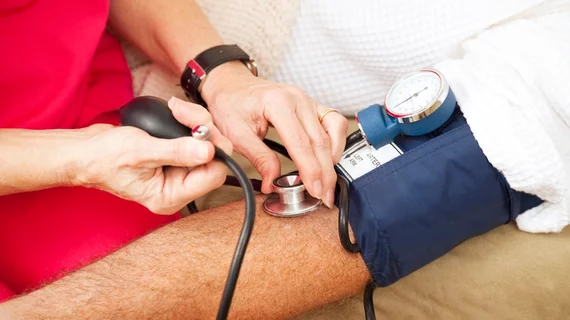Taking steps to keep older patients’ systolic blood pressure under the 120 mmHg mark could lower those patients’ risk of MI, stroke, death and mild cognitive impairment, according to a new study—but it could also fast-track a decline in kidney health.
The study, authored by Nicholas M. Pajewski, PhD, and colleagues and published in the Journal of the American Geriatrics Society, focused on optimal BP control in adults aged 80 and up. The lifetime odds of developing high blood pressure are around 7 in 10 for older patients, the authors said, and while American College of Cardiology and American Heart Association guidelines recommend most people 65 years and older maintain a systolic BP of less than 130 mmHg, the case might be different for more elderly patients.
“Hypertension treatment for adults 80 years or older is frequently complicated by multiple chronic conditions such as frailty, polypharmacy and cognitive impairment,” Pajewski et al. wrote. “Observational analyses indicate an attenuation of the association between elevated blood pressure and the incidence of vascular and nonvascular disease with increasing age, suggesting that the balance of risk to benefit for hypertension treatment may be different for adults 80 years of age or older as compared with adults in their 60s and 70s.
“Several studies also suggest that older adults with robust functional status may be more likely to benefit from hypertensive therapy, with weaker or null associations between elevated systolic BP and adverse outcomes in adults with impaired function.”
For their study, the team analyzed 1,167 patients from the SPRINT (Systolic Blood Pressure Intervention) trial, the majority of whom were around 84 years old at baseline and had at least three chronic health conditions. Three percent of the pool were aged 90 or older, and average systolic BP started at 142 mmHg.
Participants were randomized to one of two groups: either “intensive” treatment with a systolic BP target of less than 120 mmHg or more routine treatment with a BP target of less than 140 mmHg. SPRINT data clued Pajewski and colleagues into any heart disease events, changes in kidney function, cognitive impairment and deaths over time.
The authors reported that patients who received the more intensive treatment to lower their systolic BP below 120 mmHg experienced a lower risk for CV events over time than their peers, but they also saw a slight decline in kidney function that wasn’t replicated in the other cohort. The rate of dementia was similar between the two groups, but patients in the intensive 120 mmHg cohort were 28% less likely to develop mild cognitive impairment than their counterparts.
Pajewski et al. noted that attempting to lower systolic BP below 120 mmHg didn’t increase elderly patients’ risk for injury-causing falls—an important point since low blood pressure has previously been linked to risky falls in older adults. People with better cognitive function at baseline fared best and benefited the most from intensive treatment.
“Although our results add support to considering cognitive function in clinical decision-making for hypertension therapy, the precise threshold at which inaction or even deprescribing should be preferred is unclear,” the authors wrote. “...The cardiovascular and mortality benefits of intensive systolic BP control may not extend to older adults with lower cognitive function.”

